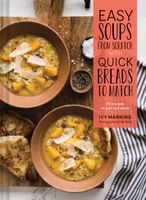Advertisement
A Baker’s Dozen—13 Tips for the Best Breads
Appears in
By Ivy Manning
Published 2017
- GET FRESH. Most of the breads in this book use chemical leavening (baking soda or baking powder) for lift, with a few yeasty exceptions. Like other pantry items, chemical leaveners don’t keep their freshness indefinitely. Mark a newly opened container of leavener with the date and discard it after 6 months. Yeast lasts 4 months when stored in the freezer.
- FAT IS WHERE THE FLAVOR IS. Fat gives quick baked goods a lot of flavor, so splurge a little; you’ll taste the difference. I use European-style cultured butter, fancy extra-virgin olive oil, and artisan cheeses for the recipes in the book. You should, too.
- MAKE YOUR OWN BUTTERMILK. The acidity in buttermilk helps activate baking powder and baking soda, which is why it’s included in many recipes in this book. Buttermilk also lends bread tenderness and a tasty tang, but it’s not something most of us have around all the time. To make your own faux buttermilk, mix 1 cup [240 ml] milk with 1 Tbsp lemon juice and set aside for 5 minutes to thicken. Use immediately.
- FREEZE WHOLE-GRAIN FLOURS. I use white whole-wheat flour and other whole-grain flours quite a bit in this book, for both flavor and fiber. Whole-grain flour is made from grinding the entire grain, including the high-fat germ. These fats can go rancid at room temperature and give baked goods an off flavor. That’s why I keep my whole-grain flours in airtight containers in the freezer. They last up to 6 months.
- WEIGH DRY INGREDIENTS. Measuring by volume with measuring cups is very inaccurate—1 cup of flour can weigh anywhere from 5 to 7 oz [140 to 200 g], depending on how you put the flour in the cup and how aerated the flour is. For the best results, get a basic digital scale with a gram setting. Weighing is not only more accurate but also faster, and it dirties fewer dishes! A scale in the kitchen is handy for weighing vegetables and meats, too.
- WORK LEFT TO RIGHT. The best pastry chef I know assembles all the ingredients to the left of the mixing bowl before she starts. As she adds each ingredient, she puts the ingredient down on the right side of the bowl. That way, she never wonders whether she remembered the salt, baking powder, or cinnamon; she’s got visual notes.
- DON’T OVERMIX. Most of the breads in this book are “short doughs”; that is, they don’t require a lot of kneading. Instead, they use fat to keep the gluten strands in the dough short, which gives them a tender and rich texture—think scones and muffins. Once you add the liquid ingredients to the dry ingredients, stir only to moisten. Unless otherwise noted, be gentle and handle dough only as much as you have to in order to get the job done.
- USE ICE-CREAM AND COOKIE-DOUGH SCOOPS. Pastry chefs use ice-cream and cookie-dough scoops to portion and transfer batter or dough quickly and neatly to baking sheets and muffin tins.
- GOOD BAKING SHEETS ARE YOUR BESTIES. These workhorses of the kitchen are not all created equal. Standard thin baking sheets warp and deliver uneven baking (and even burning). Take a trip to a restaurant supply store and buy shiny “half sheet trays,” which measure 15 by 18 in [38 by 46 cm], with a 1-in [2.5-cm] rim. You’ll pay less than you would at fancy kitchen stores and they’ll last a lifetime. Opt for light-colored baking sheets in lieu of darker ones, which retain more heat and can cause breads to brown too quickly.
- KNOW THY OVEN. Ovens can become decalibrated over time. Buy a small, inexpensive oven thermometer and place it in the center of your oven from time to time. Once the oven is preheated, cross-check the temperature your oven says it’s reached with the thermometer in the oven. Adjust accordingly.
- DON’T TRUST THE TIMER. I offer both time and doneness cues in the bread recipes in this book, because every oven is different. The baking times are a guideline, but checking the doneness by inserting a skewer into the bread or using the visuals provided is key to determining doneness. Keep an eye on your bread(s) and you will be met with success.
- INDIVIDUALLY QUICK-FREEZE. When freezing small breads like scones and biscuits for future baking, place them on a baking sheet or plate until solid. Then transfer them to a space-saving zip-top plastic freezer bag. This way, they will be easy to separate when it’s time to bake.
- COOL IT. I know you are in a hurry, but it’s best to let the quick breads, biscuits, and muffins in this book cool on a wire rack for a few ticks before serving them. It will deepen their flavor and improve their texture. Conversely, flatbreads (tortillas, pancakes, and so on) are best served immediately, as indicated in the recipes.

